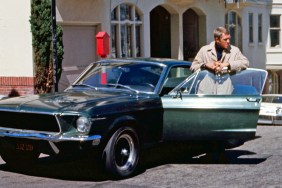
In this ongoing SHOCK column, editor Chris Alexander muses on classic and contemporary films and music worthy of a deeper discussion.

Before Walt Disney and his squeaky clean, family friendly ilk saw fit to sanitize them, the traditional fairy tale served as far more than a whimsical alternative to kiddie chloroform. As penned by those bad old Brothers Grimm especially, fairy tales of yore were cautionary morality fantasies: dark, violent warnings about the horrors and dangers in life that lurk behind every bend and within every human heart.
Take Cinderella, for instance. In the real story, those cantankerous, treacherous stepsisters dont just try on the ill-fitting glass slipper; the incident plays out as a vulgar perversion of the basest kind of vanity, as each sibling bloodily contorts their feet to fit the shoe, one even hacking off a few toes to complete the task. Grimm stuff indeed. Then theres Snow White, the story of an unfortunate lass who is set up to be murdered by her jealous mother, a crone who hires a woodsman to drag the porcelain beauty out into the woods and pull her beating heart from her bloody chest. And then take fairy tale forefather Charles Perraults Little Red Riding Hood. British fantasy writer Angela Carter did. So did Irish filmmaker Neil Jordan. Their resulting collaboration on that infamous musing on temptation, recently eaten grandmothers and cross dressing canines was the brilliant and beautiful allegorical 1984 horror movie THE COMPANY OF WOLVES, certainly one of the most underrated horror films in history.

In the early 80s, in the wake of such box-office busting, special effects soaked soon-to-be classics like Joe Dantes THE HOWLING and John Landis AN AMERICAN WEREWOLF IN LONDON, that hirsute movie monster / folklore favorite known as the werewolf reigned supreme. And yet, though US distributor Cannon Pictures chose to market THE COMPANY OF WOLVES as a bloodthirsty wolfman shocker, the theatrical poster even emphasizing the sort of man-to-beast prosthetic transformations that made FX guru Rick Baker a household name, Neil Jordans elegant and somewhat dangerous effort didnt fit into that mangy, matted mold, in fact it didnt really fit anywhere.
Collaborating closely with noted novelist (and revered feminist) Carter, self-adapting her own short story The Company of Wolves and liberally borrowing threads from her other similarly themed tales, Jordans desire was to turn the story of Little Red Riding into a caustic, bubbling cauldron of unstable sexuality, the ultimate Freudian horror fable and a twisted condemnation of male desire gone fantastically awry.

The film opens in the midst of a fever dream: Little Rosaleen (Sarah Patterson) is a modern English girl on the edge of puberty, locked in her bedroom, surrounded by icons of her rapidly dissolving childhood and smeared with a clumsily applied deep red lipstick. As she slips into restless, heated sleep, the audience is invited to enter her subconscious head space, tunnels and paths that cannibalize each other, littered with dark, spindly trees, horny, man sized teddy bears .and a pack of stalking, growling, red eyed wolves. The deeper she disappears into the haunted forest of her mind, the more authentic the surreal woods become until she, and we, are fully completely immersed in a vividly realized 18th century village ripped straight from the pages of the most evocative storybook. Rosaleen is now a farmers daughter, living with her doting parents and obsessed with her stern, slightly sadistic grandmother (a wonderfully sinister Angela Lansbury), who tortures and delights the young girl nightly with her cruel tales of supernatural shape shifters and of the various evils that men do. Meanwhile a bloodthirsty wolf is terrorizing the countryside, a beast that, upon being shot by vengeful hunters, inexplicably and terrifyingly morphs into human shape. As fear and paranoia in the village mounts, Rosaleen, wearing a bright red shawl and armed with a packed lunch basket, begins her late afternoon walk down the remote path towards Grandmas house a path that the curious and ever blossoming young woman doesnt stay on for very long.
To reveal more of THE COMPANY OF WOLVES meandering, hallucinatory plot mutations would be to grossly dampen the pictures many pleasures. This is a lush, erotic, eerie and metaphorically rich film made all the more impressive by the fact that Jordan apparently cobbled it together on a minute budget, fully exploiting Anton (Batman) Fursts amazing, Mario Bava-esque theatrical set design.
Ostensibly it is a werewolf picture because, well, its heavily armed with all manner of hairy man to monster and back again shenanigans. Many of the twisted stories that Granny relates are in fact werewolf yarns, thinly veiled horrors that, like any true fairy tale, reveal a deeper truth. Granny believes that all men are in fact wolves, predatory monsters that initially charm women, tipping their hats and gripping naïve maidens by the hand before turning on dimes and callously defiling them in every sweaty manner they wish.

One of her paranoid tales, indeed the movies visceral highlight, sees a young newlywed couple retreating to their cottage for a night of coital bliss. As the wolves howl outside, the groom (Jordan regular Stephen Rea) bolts from the home, tears off his shirt and disappears into the night, never to be seen again. Long since thought eaten by the beasts, he returns years later a different man, full of anger, bile and bitterness. When he sees his bride remarried with screaming children, he flips out; howling like a madman, tearing at his flesh, ripping off strip after strip of skin to reveal the pulsing, fanged werewolf underneath. Christopher Tucker, who designed John Hurts painful make up in David Lynchs masterful 1980 film THE ELEPHANT MAN, makes this scene a real show stopper, bloody and horrific.
But unlike a great mass of early 80s genre films, freakish gore isnt the focus of THE COMPANY OF WOLVES, rather this is first and foremost a feminist parable about the dangers of the feminine sexual awakening. Using Little Red Riding hood as its framing device, the film is a full throttle sensory experience, stimulating the eyes (Brian Loftus cinematography is swoon worthy), the ears (George Fentons score is creepy, evocative and slightly discordant), the mind (Carters ideas and philosophies sit firmly in the forefront) and, um other fun parts. The cast is an eccentric ensemble of iconic British personalities including the great David Warner as Rosaleens father, punk princess Danielle Dax as a naked she wolf and Terrence Stamp as, of all things, The Devil himself!

Jordan would later go on to become one of the greatest living filmmakers of our time, deftly weaving between mainstream nightmares like his ace adaptation of Anne Rices INTERVIEW WITH THE VAMPIRE, to his low key pan sexual melodrama THE CRYING GAME, to the delirious heights of the outrageous THE BUTCHER BOY and the elegant erotica of his recent masterpiece, BYZANTIUM. But with THE COMPANY OF WOLVES, only his second feature, Jordan had already proved himself a master storyteller, a creative narrative force, a supreme stylist and a ballsy upstream swimming risk-taker, not afraid to take a genre that was already rubbing its tired, oozing eyes and spinning it like a top, making something disarmingly original, a dark wonder of a picture that to this day is treasured by many.
Treasured by many, yes. But ignored by JUST as many as well, a woeful fact that needs to be rectified









